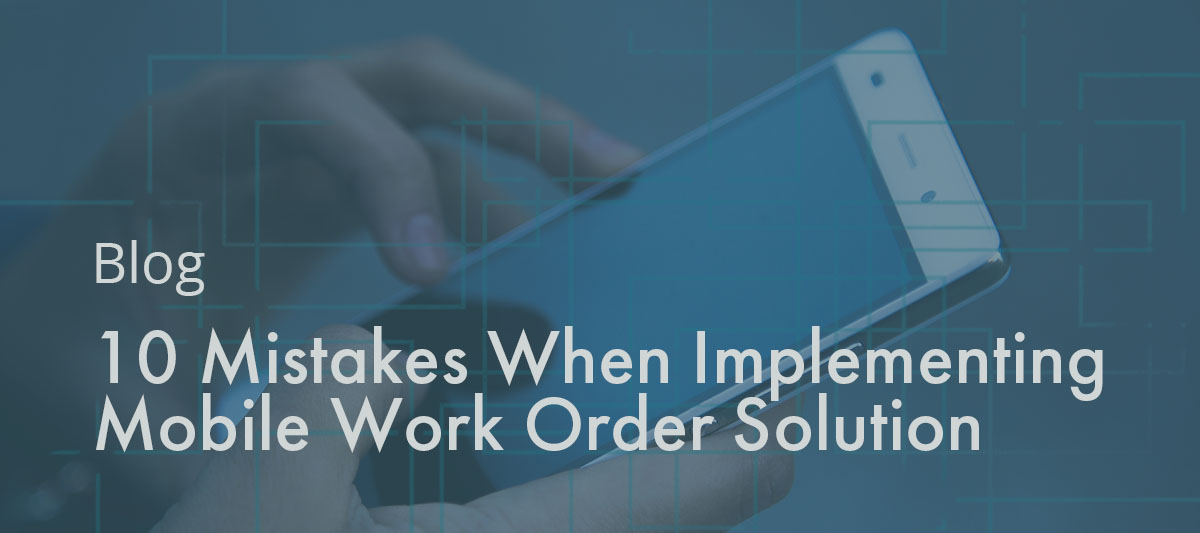Top 10 Mistakes for implementing a Mobile Work Order Management Solution

When you are looking at implementing a mobile work order management solution for your organisation there are a lot of factors to consider – and we have seen many businesses making these same mistakes again and again.
Here we are going to discuss the top ten mistakes we’ve seen being made, and how to avoid them.
1: You get what you pay for!
When it comes to investing in Mobile Work Order Management Solutions, knowing that you ought to have one and understanding how to get what you need are often very different things. With this in mind, we’ve seen too many businesses opting for the least expensive option, thinking that all systems are much the same, and then failing to get any real benefit from the software and tools they’ve chosen. This leads to businesses thinking that Mobile Work Order Management Solutions aren’t really for them at all – when in fact they’ve simply failed to match their solution to their needs!
While the initial outlay for the right systems can seem significant, the returns and efficiencies the right set up will bring to your business will more than pay for itself in less time than you would expect.
Talk to our team today about your specific needs – not only can we guide you to the right technologies and devices, but we can tailor the software to suit your exact requirements, and probably at a lower cost than you might expect.
2: Planning!
When you’re setting your system up you have to plan what you want from it – meticulously. While we can, of course, tweak the functionality and expand the initial software beyond what you select, you have to know precisely what it is that you want to get from your system in order to really reap the benefits.
We can advise, from our experience of working for many years with a wide range of industries, but you should plan in advance what it is you’re hoping to achieve – and communicate that clearly.
3: Full functionality.
When businesses implement a Mobile Work Order Management Solution they often pick a package from a spec without really looking at the finer details of what that solution can achieve for them – and then they plough on using the new devices and software without ever really exploring all the many and varied ways in which it can help.
Our team have so much experience, and so much knowledge, and can train your team to fully expand the benefits of your chosen systems, and you’ll be amazed by what a difference the right solution brings to your business – don’t just use the basic functionalities of your system, explore every avenue and revolutionise the way you do business, every day. Simplify, streamline and speed up every aspect of the day-to-day, and you’ll see an enormous impact.
4: It takes time!
Implementing an entire new system across your whole organisation takes time – not just to set up and connect the system, but to train, tweak and perfect – ensuring that the entire workforce understands and utilises the system. Streamlining a system isn’t an overnight job – and it can take longer than you think to perfect it.
Many businesses get frustrated by the time it takes to fully implement the new system – but again, once things are running smoothly, the time saved across all processes is worth the investment of man-hours and facilities initially.
Let our representatives walk you through the training and implementation, and try not to get frustrated when things need more of your attention than you expected; perfection takes time – but it’s worth every minute to see the impact on your business.
5: Pick your people!
There’s often an attitude of “That’s not my job” when it comes to implementing a new system – and while the executive team may be on board, it’s important that other vital stakeholders – from every department – are involved in the decision making, design and execution of the system to make the transition as smooth as possible. If the right people are involved from the beginning of the process they are actively involved in ensuring that the right decisions are made, and that things work the way you need them to. After all, the executives aren’t the people doing the daily grind in the trenches – and you need people involved who can say more clearly what it is they need the system to do, and who will ensure that it happens.
6: Train the team.
Ineffective training is the biggest issue when you implement a new system – not only does it mean that you don’t get the best out of your new system, but it also leads to dissatisfaction in the workforce as more and more voices mutter that they don’t understand the new programmes or technologies, that it doesn’t do what they want, and that they want to go back to the way things were.
Investing in a full and detailed programme of training – with ongoing support and communication over an extended period of time – is another outlay that we see far too many organisations try to skip, and it’s absolutely vital if you want to get the best out of your new systems to invest in the right training and support to help integrate the Mobile Work Order Management Solution into your organisation at all levels effectively.
7: Gimme gimme gimme!
While your new system can streamline a great many aspects of your organisation’s day-to-day business, many businesses make the mistake of wanting it all – and asking for far too many expansions, programmes or systems that simply aren’t needed.
Being specific about what you want, what benefits you expect your new system to bring, and the steps you want to reduce in running your business means that you can tailor what you get to exactly what you need, and you won’t be left with clunky technology that doesn’t really help because you’re asking far too much of it, and investing too much time in things you don’t really need.
Our advisors can help you to specify precisely what you need, and ensure that your new system meets those needs – without getting carried away.
8: Take out the trash.
When a new system is implemented we often see that outdated, old systems aren’t effectively decommissioned – meaning that legacy applications loiter and reduce the efficiency of the new system.
When the new system is rolled out, make sure that the previous incarnation is effectively removed from play, or you’ll end up maintaining and financing applications and systems that you aren’t using, which are simply draining resources and getting in the way of the new.
9: Maintenance!
Pressing ‘go’ isn’t the only step to implementing the new Mobile Work Order Management System; once the new technologies are in place, you can’t just let it run and hope that it’s giving you its best.
Ongoing maintenance can stop any bugs from becoming big issues, ensure that what you selected initially is truly what your business needs, expand the system to include more functionality over time as your needs expand, and ensure that your technologies stay completely up to date.
We offer ongoing support with all of the systems we design and implement, and investment in this ongoing support is the best way to guarantee that you continue to get the best out of your system for many years to come.
10: Future proofing
New technologies are constantly being developed and designed – picking an off-the-shelf solution might meet your needs right now, but will it continue to do so in years to come?
Investing in the right systems from the right people comes with the knowledge that the software you’ve chosen can be expanded as newer technologies become available to better utilise the most modern business methods, with support and development, for many years.
Here at Mobiess we don’t just offer one-stop, button push solutions – we work with organisations to ensure that your needs are met, not just now, but moving forward, as your needs change over time.
Call us today to discuss your needs, and we can work with you to create the best Mobile Work Order Management Solution for you.


